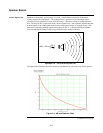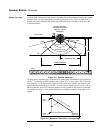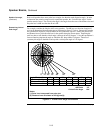
2-8
• Increasing the Signal-to-Noise Ratio:
Intelligibility degradation from reverberation is essentially a signal-to-noise issue, however
when the noise is specifically caused by reverberation it is referred to as the “Direct-to-
Reverberant” ratio. Increasing the direct sound field at the listener improves the direct to
reverberant ratio and therefore the signal-to-noise ratio. You can increase the direct sound in
several ways:
1. Move the speaker closer to the listener and reduce the wattage of the speaker:
This places the sound where it is needed and minimizes excitation of the room’s
reverberation, at the expense of additional speakers.
2. Increase the speaker density and reduce the wattage to each speaker:
This increases the direct sound heard by the listener by creating overlapping regions
of coverage.
3. In areas with high ceilings, specify a more directional speaker:
A speaker that is more focused (has a higher “Q”) concentrates most of the sound energy
in a tighter beam than low “Q” devices. This is important in areas with high ceilings to
reduce the effect of multiple late arriving sounds.
Note: See the section later in this chapter entitled “Speaker Dispersion Angle and ‘Q’”
for more information.
Room Acoustics, Continued
Countering the
Effects of
Reverberation,
(continued)


















